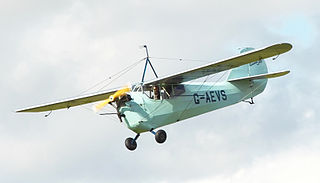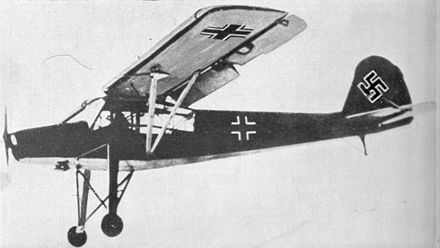
The Curtiss JN-4 "Jenny" was one of a series of "JN" biplanes built by the Curtiss Aeroplane Company of Hammondsport, New York, later the Curtiss Aeroplane and Motor Company. Although the Curtiss JN series was originally produced as a training aircraft for the U.S. Army, the "Jenny" continued after World War I as a civil aircraft, as it became the "backbone of American postwar [civil] aviation."

The Lockheed Model 18 Lodestar is a passenger transport aircraft of the World War II era.

The Vultee BT-13 Valiant was an American World War II-era basic trainer aircraft built by Vultee Aircraft for the United States Army Air Corps, and later US Army Air Forces. A subsequent variant of the BT-13 in USAAC/USAAF service was known as the BT-15 Valiant, while an identical version for the US Navy was known as the SNV and was used to train naval aviators for the US Navy and its sister services, the US Marine Corps and US Coast Guard.

The Avro Canada CF-100 Canuck is a Canadian twinjet interceptor/fighter designed and produced by aircraft manufacturer Avro Canada. It has the distinction of being the only Canadian-designed fighter to enter mass production.

The Beechcraft Model 18 is a 6- to 11-seat, twin-engined, low-wing, tailwheel light aircraft manufactured by the Beech Aircraft Corporation of Wichita, Kansas. Continuously produced from 1937 to November 1969, over 9,000 were built, making it one of the world's most widely used light aircraft. Sold worldwide as a civilian executive, utility, cargo aircraft, and passenger airliner on tailwheels, nosewheels, skis, or floats, it was also used as a military aircraft.

The Sikorsky HH-52 Seaguard was a single turbine engine, three-blade rotor amphibious helicopter. Originally developed as a commercial venture by the Sikorsky Aircraft Corporation of Stratford, Connecticut, it was used by the United States Coast Guard primarily for air-sea rescue. The HH-52 has been replaced by non-amphibious types such as the HH-65 Dolphin, which rely solely on the use of a winch from a low hover to conduct rescue operations.

The Ryan PT-22 Recruit, the main military version of the Ryan ST, is a military trainer aircraft used by the United States Army Air Corps during WWII for primary pilot training.

The Aeronca L-3 group of observation and liaison aircraft were used by the United States Army Air Corps in World War II. The L-3 series were adapted from Aeronca's pre-war Tandem Trainer and Chief models.

The Hispano Aviación HA-1109 and HA-1112 are license-built versions of the Messerschmitt Bf 109G-2 developed in Spain during and after World War II.

The Percival Pembroke is a British high-wing twin-engined light transport aircraft built by the Percival Aircraft Company, later Hunting Percival.

The Stinson L-1 Vigilant was a 1940s American light observation aircraft built by the Stinson Aircraft Company at Wayne, Michigan. The aircraft was operated by the United States Army Air Corps as the O-49 until 1942.

The Aeronca C-3 was a light plane built by the Aeronautical Corporation of America in the United States during the 1930s.

The Laister-Kauffmann TG-4 was a sailplane produced in the United States during the Second World War for training cargo glider pilots. It was a conventional sailplane design with a fuselage of steel tube construction and wooden wings and tail, covered all over with fabric. The pilot and instructor sat in tandem under a long canopy.

The Bell H-13 Sioux was a single-engine single-rotor light helicopter built by Bell Helicopter. Westland Aircraft manufactured the Sioux under license for the British military as the Sioux AH.1 and HT.2.
The Carlson Criquet is an American, two-seats-in-tandem, high wing, strut-braced, single engine, homebuilt aircraft that was designed by Ernst W. Carlson and produced by Carlson Aircraft of East Palestine, Ohio in kit form. The prototype was completed in 1999.





























